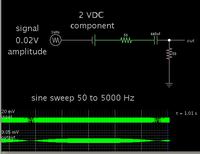eigenroot
Junior Member level 3
I need to amplify a time dependent signal which has a large DC background (at least 100 times larger than the signal amplitude). So I think I need something to filter out the DC background. A big capacitor can do this. But at the same time I also see something called DC block. I notice that most DC blocks have higher high cutoff frequency (tens of GHz) than I need, because the bandwidth of my signal is 10MHz at most. However, the low cutoff frequency of these DC blocks is also higher generally (~10kHz). In my case, I need the low cutoff frequency to be lower, preferably smaller than 1kHz.
I am just wondering which one is the right animal for my situation, a large capacitor (maybe hundreds of uF?), or a DC block with very low cutoff frequency? I kinda see that DC blocks have nicer performance in high frequency part, but are they good for my case?
I am just wondering which one is the right animal for my situation, a large capacitor (maybe hundreds of uF?), or a DC block with very low cutoff frequency? I kinda see that DC blocks have nicer performance in high frequency part, but are they good for my case?
Last edited:
